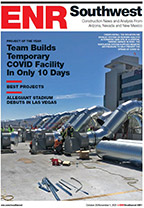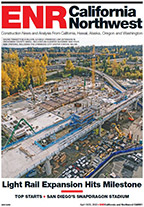Vancouver, B.C., residents better not fall too deeply in love with the 27,500-seat Empire Field, which is on course for a June 20 completion. The stadium, built to host the Canadian Football League’s BC Lions while the team’s current home, BC Place, is under renovation, will only exist in its current form until November of next year. Then, like recyclable scaffolding, North America’s first-known temporary stadium for professional football—constructed from some 15,000 parts shipped from Switzerland in 70 containers—will be dismantled and shipped home, where it will be reincarnated as another temporary sports facility.

This type of recyclable stadium may be foreign to North America, but it is common in Europe, says Martin Blackburn, Vancouver branch manager for Switzerland-based Nussli Special Events (Canada) Ltd. Nussli is erecting and removing the stadium under a $12-million contract, which is 24% of the cost of building a venue from scratch.
BC Place stadium owners Pavilion Co. needed a temporary home for the Lions, the Vancouver Whitecaps professional soccer team and other events while the home stadium undergoes a renovation. Nussli is scheduled to complete construction in 15 weeks, five days prior to opening day.
About one-quarter of the stadium’s galvanized-steel pieces were already in town, used during Vancouver’s February Winter Olympics. The rest of the stadium has been arriving from Switzerland via Montreal. Containers still were arriving in May, making logistics “quite challenging,” says Blackburn.
Customers aren’t picking stadium designs off a menu, but the giant Meccano-like pieces are the same for a 1,000- or 50,000-seat venue. “I can’t say that this stadium was built somewhere else. It is a lump of components brought together,” says Blackburn.
The stadium is designed to last for up to two years. It has a concrete foundation, but only for roof support. A primary difference in building a temporary facility, aside from reusable components, is a proprietary scaffolding system that is demountable for support, rather than a concrete slab. Otherwise, the stadium is erected conventionally, from the ground up and from the front back.
Seismic-resistant design is required in quake-prone Vancouver. To accomplish this, Nussli hired Abbotsford, B.C.-based Clearbrook Iron Works to design and construct a steel-column and truss roof, instead of the traditional aluminum and canvas covers used in Europe. “Because of snow, wind and seismic loading, that would not work here,” Blackburn says.
Aside from the reusable components, the stadium is not exactly sustainable, thanks to the imported parts and crew. To build its system, Nussli brought in about 30 “skilled” workers from Germany and Switzerland. The project had a peak workforce of 70.




Post a comment to this article
Report Abusive Comment